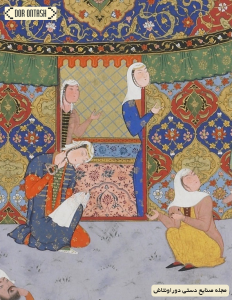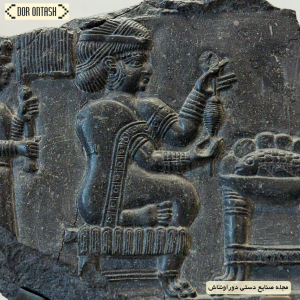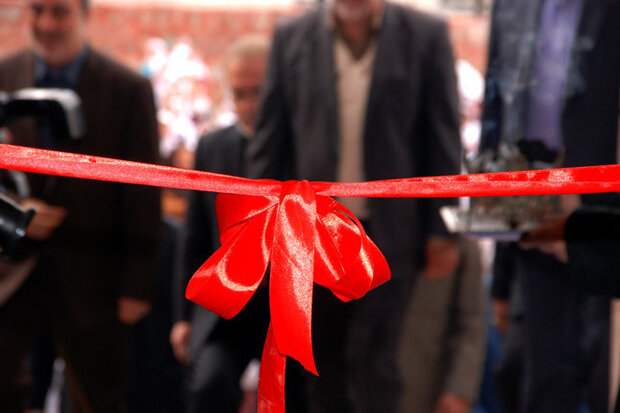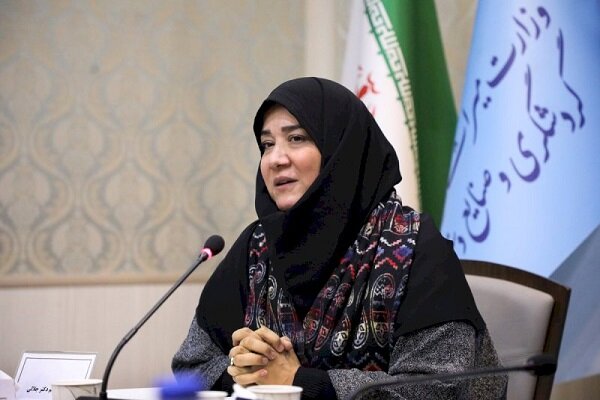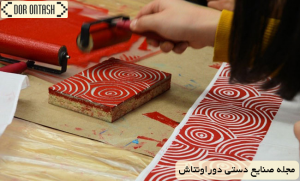The art of weaving and its history
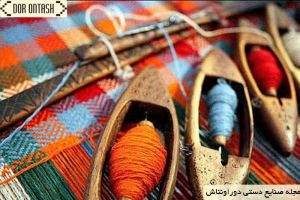
Weaving is the process of forming and making fabric by interweaving two or more sets of threads using a fixed machine called a loom in the modern era and by hand and basic and simple machines in the ancient era.
Humans have started using woven fabrics since the beginning of history. If we exclude the Paleolithic Age, the history of civilization will largely be the history of weaving.
Although early civilizations used coarser threads to make cloth, which were very rough and tough, there are also sources of fine cloth creation through silk filament in China.
Woven fabric from the early centuries of Islam to the Mongol invasion
The style and texture of different types of fabrics in the early centuries of Islam
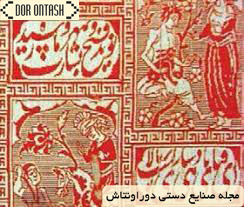
Wareh al-Buyeh (250-420 AH) and Seljuq is distinguished because of the progress achieved in cultural affairs. In Darwan al-Buyeh, which arose from the Tabaristan region, the silk weavings during their rule (in the fourth and early fifth centuries) have designs that are not only a continuation of the same Sasanian motifs, especially in the image of animals, but also some masterful forms. added to them. Designing one or more images in such a way that another role is obtained from their intervals is one of the old techniques of Middle Eastern design, which is frequently seen in Sassanid era fabrics. In the silk fabrics of the Al Boyeh period, these motifs are among the most diverse designs and repeat the common designs of the Mazda worship period.
“Iranian mystics who are well versed in the history of their tariqa have repeatedly pointed to the remains of images, allusions and beliefs of the ancient Iranian religion in Sufism, and this meaning is recorded on the silk fabrics of the 4th and 5th century. These silk fabrics are important documents in history. They are considered culture and in terms of the art of weaving, they have a perfect score in design and texture” (Pope, 98).
Some of the old designs are slightly different from the ancient examples even in style. Despite its small size, the double-headed eagle looks huge due to its abstract design. The horns of an antelope on the head of this royal bird show the durability of pictorial allusions, and the pattern of the winged king on the big chest of the bird also speaks of the same meaning. The lion and peacock on both sides of the tree of life are completely Sasanian in meaning and appearance. Although in their design and proportion, they have not completely followed the old tradition. These animal motifs are limited in a circle like Sasanian works.
Another example of this art is a design that shows two lions guarding a tree called “Hervisp ovum”. From the top of this tree, two imaginary birds fly down and sprinkle blessings on the ground.
The peacocks, which are the sign of the starry sky, have become very small in the rhombus frame, which is an old allusion to the moon, in this design, while in other designs, they are shown big and large, and to show their importance, other animals such as cats are placed under them. They have put their forks.
Although according to ancient traditions, the distance tree grew from a jar of clouds, it is not subject to a specific design method. The broad half-leaves with large dots at the end of their veins are adapted from the painting style of Kashan enamel pottery. The legendary winged deer, although rarely seen in these motifs, have a history of their own. But the shape of insects is a type of innovation that has no special meaning and value. The contrast between the smallness and compactness of the circle motifs with the open space of the middle designs is strange and at the same time masterful. This design, which includes different shapes in consecutive and parallel strips, is full of positive and negative roles. One of them is the design of a palm tree with a thin stem between two peacocks, whose leaves look like a human face when you look closely, and this is out of the usual pre-Islamic designs.
Maybe this fabric was made of linen. From a bronze rod that was discovered in Hesar Damghan hill with other works belonging to the third millennium BC, it is clear that it was used for spinning and very thin threads were woven with it, and this is the reason for the development of spinning at that time.
The Achaemenians were famous for weaving soft and delicate woolen fabrics, and these fabrics have made their luxurious and beautiful clothes famous. On the designs of the glazed tiles obtained from the Achaemenid buildings in Susa, the same floral fabrics can be seen, which are definitely embroidered on the fabric.
But the fame of Iranian textile art reached its peak in the Sassanid period. It was during this period that silk came to Iran from China, and silkworm breeding and silk industry were widely spread in the country itself. From this period, only a few pieces of silk fabric and one or two pieces of woolen fabric are left.
But the motifs of the flowers of these fabrics left on the images of Taq Bostan and Sasanian silverware complete our information in this regard and show the full development of this art in the Sasanian period. The designs of these fabrics are very attractive and diverse, and their style has a special advantage. Although this point is more in terms of strength and sobriety of the role than in terms of elegance.
But the great transformation that happened in Iran’s religion and politics and ended the Sassanid dynasty, interrupted this industry and replaced it with Islamic idolatry, which prohibited not only religious allegorical roles but also any representation of living creatures. However, although Iranians accepted the religion of Islam, Iran, which was the heir of three thousand years of artistic resources, did not abandon the images of animals, birds and humans, which were the customs of their ancient religion.
The art of weaving and its history
Woven fabric in Iran

The skill and initiative of Iranians in the art of weaving has a long history. On the bronze blade of the ax, which was obtained with the pottery of the first era of Susa, due to the effect of copper salts, there is a trace of the cloth they were wrapped in, which shows that it was around three thousand to three thousand five hundred years ago. AD, it was common to weave fine cloth even with precision looms.
The art of weaving fabric is one of the ancient Iranian arts, fortunately, there are examples of it from the Sassanid era. In this article and the next article, after examining the history of woven fabric in the ancient eras, we will criticize the art of woven fabric in the Al-Buye and Seljuk eras.
The skill and initiative of Iranians in the art of weaving has a long history. On the bronze blade of an ax obtained with the pottery of the first era of Susa, due to the effect of copper salts
, a trace of the cloth they were wrapped in was left, from which it can be seen that around three thousand to three thousand five hundred years before Christ, it was common to weave delicate cloth even with a precise loom. Maybe this fabric was made of linen.
From a bronze rod discovered in Hesar Damghan hill with other artifacts belonging to the third millennium BC, it is clear that it was used for spinning and very thin threads were spun with it, and this is the reason for the development of spinning at that time.
From some of the motifs of Lorestan’s bronze saghres, which is in the Assyrian style, designs can be seen on the fabric of the clothes, the flower of which seems to have been woven into the fabric itself. But at this time, it is more likely that they used to embroider flowers on the fabric, and sometimes braids can be seen in the patterns, which are apparently tapestries.
The collection of Sassanid fabrics, like the arts created with other materials, are all traces of ancient pottery motifs. Of course, during the long history between these two covenants, there were important changes in terms of shape and appearance. But the great transformation that happened in Iran’s religion and politics and ended the Sassanid dynasty, interrupted this industry and replaced it with Islamic idolatry, which prohibited not only religious allegorical roles but also any representation of living creatures.
But Iran was the heir of three thousand years of artistic resources. Iranians accepted the religion of Islam with open arms, but they did not abandon the facial features of animals, birds and humans, which were the customs of their ancient religion.
Woven fabric in the Mongol and Timurid eras
A) Weaving centers
From the time of Genghis Mongol’s attack on Iran until Ghazan Khan came to power in 694 AH, it should be considered a period of artistic stagnation in Iran. But Ghazan Khan, with the encouragement of his minister of science and scientists, Rashiduddin Fazlullah, prepared the grounds for the establishment of scientific-cultural centers. At this time, Tabriz became the center of art and as a result, many artists and researchers were attracted to this center.
In general, during this period, much attention was paid to the development of industrial production and export. One of the most important export items of Iran was silk and silk textiles, which were considered part of Iran’s wealth, and part of the sex taxes were also paid in the form of silk. It is known that after the conquest of Gilan, Al-Jaito obliged the local rulers of that region to pay silk – each according to their capacity – in order to collect taxes.
With the Mongol attack, many textile centers that were active until then, such as those in the cities of Shush, Shushtar and Ray, lost their importance due to the destruction of the cities, and some were completely destroyed and disappeared. Despite this, after some time textile workshops were opened in the cities of Tabriz, Soltanieh, Yazd, Kashan and Neishabur.
It is worth mentioning that Neyshabur was one of the main centers of fabric production before the Mongol invasion, and during this period, other workshops were added to it.
Ibn Battuta mentioned the silk and kumkha fabrics, which were woven in Nishabur. In addition, Soltanieh was an important center of fabric production; Silk was imported from different regions such as Gilan and turned into cloth there. In addition to being the center of textile weaving, Soltanieh was also considered one of the major commercial centers, as colorful fabrics came from Khorasan and silk fabrics from Shirvan.
In the 9th century AH, at the same time as the Timurid rule, the eastern parts of Iran were more prosperous than other parts of the country, and Great Khorasan – which was famous for its weaving industry before this time – became more prestigious. Especially the cities of Samarkand and Herat, which were considered two important cultural-artistic centers during the time of Timur and his son Shahrukh. In addition, woven fabric flourished in the cities of Yazd, Kashan, Kerman and Tabriz, so that these centers exported their products to other places as well.
In general, Timur and Shahrukh supported art, industry, commerce and trade. Timur made Samarkand his capital and in all his wars with different lands, after the victory, he moved the artists and artisans of the defeated nations to Samarkand. He turned Samarkand into the largest scientific-artistic center, and in the meantime, he brought many silk and silk weaving artists from Damascus to Samarkand.
The art of weaving and its history
b) Types of fabrics in the Mongol and Timurid eras
The weaving of all kinds of precious woven fabrics, which existed in Iran before the Mongol conquest, flourished during the Ilkhanate period. The Mongol leaders called the cloth weavers under their power, especially the cloth weavers who were masters in gold weaving, to the centers. During the time of Ghazan Khan, due to the plan of his minister, Khwaja Rashiduddin Fazlullah, the trading of gold and wire was freed, and the amount of these two metals increased in the Ilkhanid countries. As a result, it caused the production of more silk weaves.
In addition to the weaving of zari types, silk weaving was also produced in the Seljuk style in centers such as Neishabur.
There is little information about the weaving art of the Timurid period as far as it can be deduced from the texts; Because there is rarely a piece of fabric that belongs to this period. Despite this, we can safely say that many of the fabrics that are attributed to the Safavid period today belong to the Timurid era. In this period, the attention to this art-industry was so much that it caused its growth and prosperity, and eventually, this prosperity evolved and reached its peak in the Safavid era. Unfortunately, unlike other arts of the Timurid period, such as painting, metalwork, book design, the art of textile weaving has been less studied.
In general, the fabrics of this period can be divided into several groups:
1. Silk fabrics that are similar to the Seljuk period and before that in terms of texture. Like double-weave fabrics, but not to the extent and quality of that time.
2. Types of zarbaft fabric, especially a zari type in which gold and wire are used in large quantities, so that the fabric is heavy in terms of weight.
3. Velvet and low-pile or low-pile velvet (perhaps it means the same lack of sleep that is used in the term velvet). Ibn Battuta – as mentioned in part “A” of this chapter – mentioned its production in Nishabur.
4. Painted fabrics are another group of fabrics of this period. One of the reasons for its popularity and development at this time was the arrival of Chinese goods, including painted fabrics, to Iran, which were welcomed and as a result, its production increased. In addition to the fabrics that were carved with a mold, a kind of painting on the fabric was common, which was done with wax.
5. Another group of fabrics of this period are fabrics on which embroidery was done, the main center of which was Kerman, and it was often done by women artists.
c) Designs and decorative motifs of the Mughal and Timurid periods
In general, the decorative subjects of Mongol and Timurid fabrics are divided into several groups:
1. Motifs and subjects that show the continuity of the early Islamic and Seljuk style in this period.
2. Examples that include direct influences of Chinese art due to more contact with China.
3. A group of fabrics whose decorative motifs show the characteristics of this era. In picture number 9, we see a silk fabric decorated with tangential geometric frames, which were very common in the fabrics of the early centuries of Islam, and two birds are placed face-to-face in each of the frames. Although this fabric represents the continuity of the decorative methods before it, but in the spaces between the frames, the dragon motif has been decorated in the style of Chinese art, which can be said to be a well-defined combination of the previous methods with the new method. This example belongs to the first group.
Another group of decorative subjects is influenced by Chinese art and culture. Due to the traditional and ethnic tendency of the Mongol patriarchs towards Chinese culture and traditions, and with the beginning of the establishment of Chinese artisans and artists, the preparations for an effective attitude to acquire Chinese art experiences were created among Iranian artists. Although familiarity and contact with the culture and art of this land is related to a much older era than the Mongol rule over Iran, and the cultural relationship between Iranians and Chinese continued continuously throughout history, at this time, more influences are observed according to the wishes of the patriarchal rulers. Therefore, on the artworks of this period, simorgh and dragon motifs in the Chinese art style can be seen many times, although before this time, simorgh motifs with special concepts were also depicted on fabrics in different ways.
Another type of fabric left from this time – which can be said to be one of the characteristic weaves of the Ilkhani period – is the Zarbaft fabric, which is woven from gold and silver fibers and has very delicate geometric decorations similar to Khatam work. On the edges of this cloth, the phrase “Al-Kabir Aala” is usually written – which is one of the common expressions of this time. It is woven in the Chinese style. (Picture No. 11)
One of the important features of art in the Ilkhanid period and especially Timurid – due to the formation of major cultural-artistic centers in the cities of Tabriz and then in Samarkand and Herat – is the closeness of some arts to each other; Because in these art centers, artists of different disciplines worked together and exchanged ideas, among which the closeness of the art of miniature painting to woven fabric is remarkable in terms of decorative subjects. In a way, the fabric can be classified under art schools such as Tabriz, Herat, and even in the Safavid period, the Isfahan art school.
Woven fabric from the Safavid period to the end of the Qajar period
A) Weaving centers in the Safavid period
The 10th and 11th centuries AH can be safely called the golden age of textile art in Iran. During this period, all kinds of silk, zari, velvet, cashmere, kalamkar fabrics, as well as all kinds of embroidery on fabric were made in textile workshops in Isfahan, Yazd, Kashan, Kerman, Herat, Mashhad, Rasht, Tabriz, and Qom. They were famous for making a type or types of fabric. For example, Isfahan was the center of production of all kinds of woven fabrics and kalamkar. In Yazd, silk fabrics were woven, and in Kashan, all kinds of silk and velvet fabrics, including silk velvet and embossed flower velvet; As stated in Chardon’s travelogue: the wealth of Kashan people is based on silk weaving, and only in one of the suburbs of Kashan city called Harun, there are thousands of silk weaving workers. Kerman was the main center for making cashmere shawls. In the cities of Isfahan, Yazd and Kashan, all kinds of woven fabrics were woven, and the weaves of each place had their own characteristics; As zari with mihrabi design were mostly produced in Yazd and flower zari with human motifs were mostly produced in Isfahan, or shawl fabrics were woven in the cities of Yazd and Kerman. Kerman cashmere shawl fabric was very delicate and was made from the wool of Kerman goats – which is similar to silk; But Yazd shawls did not have this quality, because cotton was used instead of wool.
One of the characteristics of Safavid textile art, which started from the Timurid period and reached its peak at this time, was the collaboration of painters and weavers in the art center of Isfahan. So that many fabric designers were famous painters of this time. One of the famous weavers of the time of Shah Abbas is Ghiyasuddin Naqshband. He managed the gold weaving and velvet weaving workshops of Isfahan, which Shah Abbas had established. He was one of the masters of Zari Bafi art style, who was famous for his eloquence and gentleness in addition to fabric design and texture. He was from Yazd and at the request of Shah Abbas, he took charge of gold weaving workshops in Isfahan. But after living in Isfahan for some time, he returned to his hometown and flourished this art there.
In the cities of Isfahan, Yazd, and Hamadan, kalamkar fabric was also produced, but the main center was the city of Isfahan, which has continued ever since. The neighborhoods of Chit Sazan Bazaar and Rangrozha Bazaar in Isfahan have been the center of Qalamkar fabric production. All kinds of embroidery such as glabton embroidery, cocoon embroidery, ajideh embroidery, ten-one embroidery and pateh embroidery were also done in the cities of Kerman, Rasht, Mashhad, Isfahan and Kashan.
ب)
Types of fabrics in the Safavid period
Since the Safavid period is associated with the peak of weaving art in various fields, especially zari weaving, velvet weaving, calligraphy and all kinds of embroidery on fabric, therefore, in this section, we will give a brief description and history of each of the mentioned methods.
zari bafi
Zari weaving is one of Iran’s national arts with an ancient background, which reached its peak of beauty in the Safavid period in terms of variety of textures, patterns and colors. Perhaps one of the reasons for the continuity and progress of this art and craft throughout history is the support of kings and rulers. Basically, a fabric with gold and silver fibers or glabton is called Zari or Zarbaft. Glabton is also made of pure and delicate silk thread with gold or silver coating. Gulabton thread has degrees of fineness and thickness that are very effective in zari weaving.
Zari fabric is divided into several types in terms of weaving:
1) Satin gold, whose texture is very delicate.
2) Zari Hajana, in the texture of which the number of Glabton wefts is more, therefore the fabric is thicker.
3) Zari mat whose texture is exactly like mat texture.
4) Zari Lope woven on the back of the coil, the motifs woven on it are similar to the embroidery on the fabric, and the weft threads on the fabric are clearly defined, and the back of the fabric is exactly like the fabric on which the embroidery is done, and the threads are gathered on the back, which are distinct. .
The construction of the zari weaving machine is very simple and made of wooden tools, usually two people work with each machine; One is a gold weaver and the other is his student who is nicknamed the earring puller. The work of the earring puller is to raise and lower the pattern on which the motifs are already patterned and mounted on the top of the machine, and he guides the motifs to the weaver.
Usually, the background or in the term, the canvas of zarbaft fabrics is made of silk thread, and gulabtun is one of the weft threads with which it is patterned.
As it was said, gold cloth was often the attention of kings and courtiers, and in most historical and literary texts it is mentioned as a precious and valuable cloth. Although there are many references to gold fabric in most of the historical, literary, geographical and travelogues related to the early centuries of Islam and the Seljuk period, examples related to the mentioned period are rare. For example, in the travelogue of Atbat Naser al-Din Shah, there is a mention of the Zarbafti cloth, which was woven during the reign of Azd al-Dula Dilami (4th century AH) and was seen on the shrine of the Prophet. It is written in the same place that eight hundred years have passed since the life of this cloth. Pache Zari and Zarbaft are mentioned many times in literary texts, two examples of which are mentioned:
By the day of Zarbaft, his shroud was roaring on that Shahriar of the association
Ferdowsi
skirt and pocket, don’t try to make it dirty
Nasser Khosrow
What is certain is that the weaving of gold cloth was very prosperous during the reign of the Ilkhans (8th century AH) and the nobles were obliged to send some gold cloth and raw silk to the leaders and rulers every year. Ibn Battuta also mentioned a kind of very high-quality Zarbaft fabric that was woven in the city of Tabriz (its description was omitted). In the Timurid period, gold cloth was considered one of the exquisite goods, and the cities of Tabriz, Herat, and Samarkand were famous for its production. Despite this, the art of zari weaving reached its peak during the Safavid era, especially Shah Abbas, when zari weavers performed miracles in weaving all kinds of zari-woven fabrics that were woven in the workshops of Yazd, Kashan, Isfahan, and Tabriz. One of the main reasons for this artistic peak was the attention and support of Shah Abbas (1038-996 AH).
It is worth mentioning that during the time of Shah Tahmasb (930-984 AH) special attention was paid to this art and a special school was formed in gold weaving, which was the use of flower and plant motifs and hunting motifs. After Shah Tahmasb’s death, Shah Abbas moved the capital from Qazvin to Isfahan, and a new style was formed under the supervision of Zaribaf artists in Isfahan. One of the characteristics of the Safavid textile art, which started from the Timurid period, was the cooperation of painters and weavers in art centers. The cooperation of these two groups in the art centers of Yazd, Isfahan and Kashan led to the production of zarabafti fabrics, which are unique in their kind and are considered among the artistic masterpieces of Iran. In addition, there are two other schools in the art of weaving cloth during the Safavid period:
A school led and initiated by Ghiyasuddin Ali Naqshband, whose style in designing fabric motifs was often the use of small designs and motifs that were in harmony with each other in a general design. In the city of Yazd, zari with flower and plant motifs, surrounded by a crescent and an altar arch, were woven, and Ghiyath was also a master of this method.
It is known that he wove a moshjari woven cloth for Shah Abbas and carved a quatrain on its border that was his own work:
Oh King Sepehr, the sun meets the sun
I don’t want you to wear this gift because you are my fault. I want you to remember my fault
Some of Ghiyath’s children (Abdullah, Moez, Hossein and Yahya) were also artists like him and weaved excellent gold fabrics, and the names of some of them, like Abdullah, remain on the gold woven fabrics.
The second style that became popular in the Safavid period was the style of Reza Abbasi – the famous painter of this period. His style is the Isfahan school that he and his students invented and brought to its peak. In the matter of gold weaving, the style of Isfahan became very prosperous, which was the use of large designs and motifs, mainly with the theme of the role of man and nature, in which most of the Iranian ways were desired. Like Iranian almond eyes instead of Mongolian oblique eyes. One of the famous weavers of this style
He mentioned Muhammad Khan, Ali and Ismail Kashani and Moin who were from Kashan and others, Agha Mahmud and Mugheeth who were from Isfahan.
The best document about the collaboration between fabric weavers and painters of the Safavid period is the gold atlas sample that is available in the Museum of the Islamic Era. The pattern of this fabric is in the style of Isfahan, that is, the style of Reza Abbasi. This fabric has a date and number, and its weaver, Moin Mosev, is one of Reza Abbasi’s students, who followed Reza Abbasi’s exclusive methods in painting and designing fabric.
As mentioned, in the Safavid period, the art of gold weaving reached its peak of beauty in terms of the variety of motifs and texture, and after that, in the 12th and 13th centuries AH, it continued with the same methods presented in the Safavid period, in the centers of Yazd, Isfahan and Kashan. found, but a new method was not presented in this way and it can be said that it started to decline in terms of quality in the 13th century AH. Unfortunately, despite the fact that during the textile history of Iran, Zarbaft fabric was considered one of the indicators of Iranian art and was considered one of the most important industrial-artistic products, since then it was not paid attention to, and its long life was only observed by traditional arts workshops affiliated with the Heritage Organization. observed the culture of the country.
Velvet weaving in the Safavid period
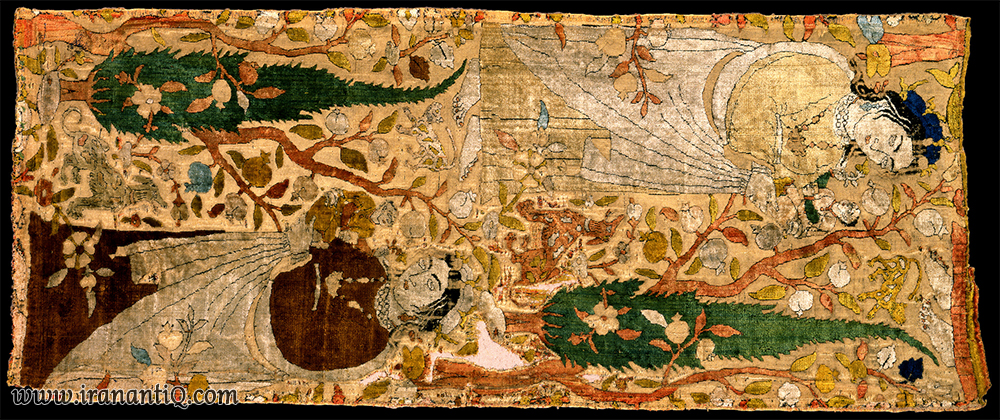
Velvet is a type of cotton or silk fabric, one side of which is smooth and the other side has soft and close piles, and these piles sleep on one side. The difference between velvet and other fabrics is that in addition to the warp and weft, which makes up the fabric, velvet also has piles. In the old texts, velvet is mentioned as Khakhkhiz.
There are two types of velvet fabric: single-sided velvet and double-sided or double-layered velvet, which has fluff on both sides.
Let it be a tent made of the blue sky, which is covered with velvet lining
Nasser Khosrow
What is certain is that the weaving of velvet fabric has a long history in Iran, despite the fact that there are no examples before the Safavid period. As in the historical and geographical texts, a kind of fabric named Kamkha is mentioned, which, taking into account its meaning, is the same velvet fabric. In the dictionary of Dehkhoda, it is stated: “Manqesh fabric is said to be woven in different materials and it stands for low sleep” and it is clear that this fabric is low sleep and the sleep is specific to velvet fabric whose piles sleep on one side.
There is no place for my hazal to Yazd.
Farrokhi Yazdi
During the Ilkhani period, the center of production of high-quality Kamkha fabric was the city of Neishabur, as Ibn Battuta has mentioned. This fabric is also exported to India.
During the Timurid period, velvet fabric was produced in the cities of Kashan and Yazd, and with the establishment of the Safavid dynasty in the 10th century AH, Shah Abbas, in addition to the velvet weaving workshops in Yazd and Kashan, also established velvet weaving workshops in Isfahan and invited skilled masters there, such as Zari weaving workshops under the supervision of Ghiyath Naqshband. (its description was passed) was administered.
In any case, the evolution of the velvet weaving technique and the preparation of velvet textiles – as it is known today – was realized in the Safavid era, and in the meantime, the city of Kashan should be considered the birthplace and place of growth of this very delicate and beautiful art.
In general, the design of Iranian fabrics in the Seljuk era acquired a subtle artistic aspect, because it was mixed with the traditional elements of Iranian painting, and in the Mongol era, it was mixed with the art of Chinese painting, and in the Safavid era, it was refined with the taste of the artists of the time, which created unique masterpieces. The skill of the master velvet weavers such as Ghiyathuddin Ali (Ghiyath Naqshband), Muhammad Khan and Ismail Kashani made them able to give the velvet fabric shine, hollowness and height (embossed patterns) by very delicately and skillfully increasing and decreasing the wefts of the fabric and the length of the knots.
The most important centers of velvet fabric production in Iran were located in the central desert area, and Kashan, Yazd, and Isfahan were among the important weaving cities. One of the types of velvet fabric that Yazd city was famous for its texture was purple purple velvet, which was decorated with golden yellow long-stemmed flowers with green leaves. The feature of most of the Kashan velvet fabrics in the decorations were human motifs in the scenes of fighting and hunting.
penmanship
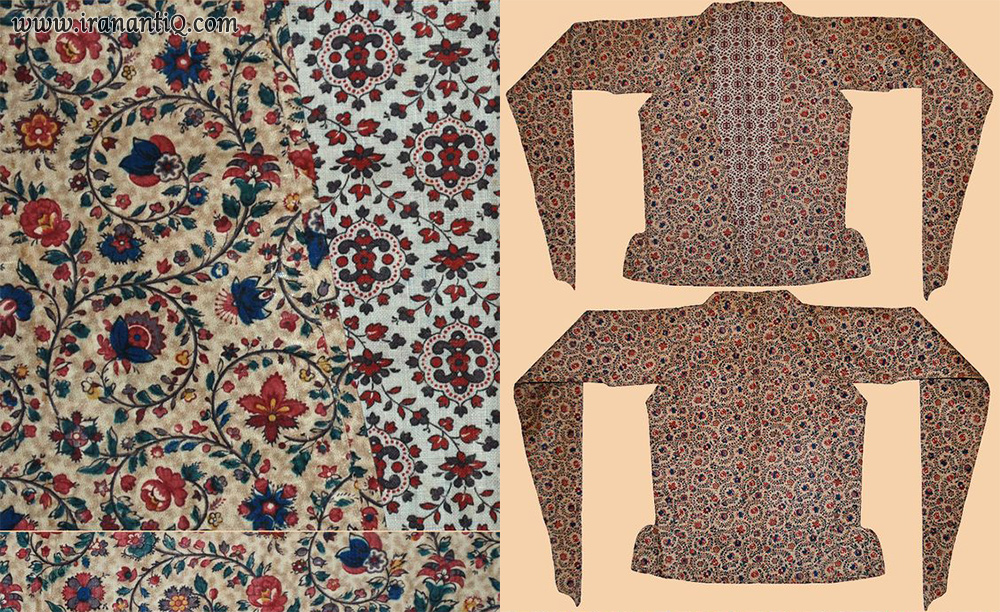
The history of painting on cloth is not very clear, but what is certain is that in the early centuries of Islam, in the lands of Iran and Egypt, there was such a common industry that they made designs on cloth with wooden molds. After the Mongol invasion of Iran and the establishment of the Ilkhanate government, due to the increased connection between Iran and China and the arrival of Chinese goods including painted fabrics to Iran, the method of engraving on fabric quickly became popular in Iran.
With the existing works, it is possible to attribute the peak of calligraphy art to the Safavid period in terms of the amount of production and variety of motifs. The major centers of calligraphy were the cities of Yazd, Hamedan and Isfahan, but Isfahan was considered the main center and has been the continuation of this art ever since.
Qalamkar fabrics are divided into four types in terms of working methods:
1. An ordinary penman who works with wooden molds.
2. A pen on which verses of the Qur’an, supplications and hadiths are written with Kufic, Nashq, Thuluth and Ghbar lines. Ayat al-Kursi or Nadali shirts, which were worn to ward off diseases and disasters, are considered to be of this type.
3. Goldsmith penmanship, which is a type of painting on cloth with gold; In this way, gold was dissolved in water and used instead of paint to make patterns on cloth. These fabrics were extremely expensive and special for the courtiers of the Safavid government.
4. Indian penman whose motifs are more inspired by Indian carvings.
The preparation of the fabric for patterning is done in the following steps: in the first step, the fabric, which is usually made of canvas or silk, is called Nasheor; This means that they wash it well with fresh and clear water and then make it mazo by combining several ingredients such as: pomegranate skin, gezbar and mazo; That is, they soak the cloth in the solution of these substances and after some time take it out and dry it. After this stage, the fabric is ready to be patterned, just like a canvas. In the first step, the desired motifs are designed, and then carved on wooden molds that are usually made of pear or hawthorn wood (due to its strength).
The preparation of template wood for drawing on fabric also has the following steps: first, it is left in the sun until it dries completely, then it is smoothed with sandpaper and a five-millimeter layer of melted tallow is applied on it, when the tallow has been on it for a while They shave it and rub it with pomegranate peel until the wood is completely smooth and soft, and finally, they carve the design on the wood (pictures 15, 16, 17). It should be kept in mind that a separate template is needed for each of the colors used in the role of penman; That is, the template with which black color is drawn, they can no longer use it for green or red color. For example, if a Qalamkar fabric has four colors, it goes under the master’s hands four times; It means that it should go under the master’s hand once for black motifs, once for red motifs and similarly for other colors. Because the black and red colors are the main colors of the Qalamkar fabric and in order for these colors to remain constant – when the patterns of these two colors are drawn on the fabric – the fabric is placed in a large container in which a solution of the brain of the Runas and pomegranate skin is poured. They boil the solution at 70 degrees and gradually bring it up to 100 degrees. This practice is called Patili. After drying the fabric, other colors are imprinted on the fabric in order.
The main colors of Kalamkar are: black, red, blue, green and yellow, all of which are made from natural colors. To obtain secondary colors, primary colors are combined to a certain extent.
The above colors consist of the following materials:
Black color: black alum, iron rust, castor oil and incense
Red color: white alum, rose, sesame oil, incense
Blue color: Peacock indigo, sulfur essence, grape juice, perfume, glycerin oil.
Green color: white alum, peacock indigo, turmeric, incense, glycerin.
Yellow color: pomegranate peel, white alum, turmeric, incense, glycerin.
In the combination of all colors, katira is used to prevent the color from spreading on the fabric and glycerin is also used because it prevents the color from drying in the groove of the wooden molds.
The patterns of kalamkar fabrics are usually similar to carpet patterns, and it can be considered as a subcategory of carpet patterns, which are:
1. Lakh and Tareng patterns
2. garden design;
3. flowers and vases;
4. Inscribed;
5. altar
6. house house;
7. Cypress and Bete Jakeh.
In addition, epic and heroic and sometimes romantic stories have also been depicted in the curtains of Kalamkar coffee house.
embroidery

Different types of embroidery art on cloth is one of the most delicate and beautiful arts that Iranians – especially Iranian women – had a special skill in preparing. Embroidery, or in other words, embroidery and crocheting, has been common in Iran for a long time, and although some of these examples have survived from the Safavid period onwards, many historical texts before this period also refer to this art and its types. has been As in the world, it is made of a fabric called Sqlaton – which is a type of silk fabric embroidered with gold. It has been mentioned that it was made in Isfahan, or the Kurdish cloths that were made in Khuzestan are mentioned in the mentioned book, and it was a type of cloth that was used to sew the edges of the book with a needle. In later periods, various references have been made to the art of crocheting and embroidery on fabric in Isfahan and Kerman.
In the Safavid period and after that, interesting examples of all kinds of embroidery have remained, and artists created very beautiful and favorable motifs of flowers and leaves and human and animal motifs on the fabric with colored silk needles and threads, and gold and silver fibers. have done
There are various types of embroidery, which we mention a few examples:
1. Khatami. A type of embroidery that is very common in Iran and is known as Khatami. It consists of a number of pieces of fabric with different patterns and colors that the artist put together with a special skill and sewed on the fabric and then embroidered the stitches with colorful silk. This type of work is similar to Kashmiri shawls in terms of elegance and beauty.
2. Embroidery Another type of embroidery is using sequins, which are sewn on fabric, or the use of flowers and patterns with silk threads, with gold and wire threads, which are sewn on exquisite fabrics. This method also refers to another type of embroidery, which is designed with narrow metal strips on the fabric.
3. Cocoon embroidery and wick embroidery. Sometimes it is prominently embroidered on silk or velvet fabric with glabton threads or colored silk threads. In cocoon embroidery, the patterns are smaller and more delicate; But when they want larger patterns and lines, first they put a long tube of thread or fabric – exactly like a wick – on the fabric according to the plan and sew on it with gold and silver threads, which is called wick embroidery; That is, the motifs appear large and prominent.
4. Ajide Dozi It means stitches and stitching; In this way, the space between the fabric and the lining is placed with a layer of cotton or wool to make it thick, and then the main fabric is stitched, and because of this, the thickness and the presence of the layer and the depressions of the needle, the patterns, hollow and prominent It seems
5. embroidery The main center of its preparation is in Kerman and it is considered one of the most delicate Iranian arts. In this type of embroidery, the artist embroiders different motifs of birds, leaves, and cypress trees on the silk shawl fabric. For this purpose, first the desired motifs and designs are prepared on paper and then they pierce the paper with a needle. After matching it on the fabric, they transfer the designs to the fabric by pouring ash into the holes. After that, they sew patterns on the shawl with colored threads. In Kerman pates, the design of four bates on four sides and a central bergamot and sometimes four bouquets on four corners has been very common. Another common design of pates is the peacock design, in which a large cedar is sewn in the middle of the fabric, and two peacocks are sewn on both sides of the fabric.
Each of the cities of Iran were skilled in a specific type or types of embroidery, such as the cities of Isfahan and Kashan, were famous for the art of embroidery, glabton embroidery, and silk embroidery, and in Tabriz, a type of needlework was made with woolen thread. A type of zardozi on woolen cloth was common in the Turkmen of the Sahara, which is called Chekin. In Rasht, there was also a type of embroidery that was done on mahout or velvet fabric. From the Safavid period to the end of the Qajar period, the art of embroidery on fabric continued to be done with the aforementioned methods on different types of fabric.
c) Decorative designs and motifs
With all the diversity of decorative motifs on the fabrics of the Islamic era, they can be divided into several general groups:
1. Human motifs shown in the scenes of fighting, fighting and hunting.
2. Animal motifs
3. Vegetal motifs and designs including different types of trees and flowers.
4. Various geometric designs.
5. Mythological motifs such as simorgh and dragon or symbols of mythological subjects.
6. Decorative designs and motifs, such as Bete Jagah, which is a modified form of cedar, or Taranj and Lekhi, which in a sense symbolizes the full sun and the sun at sunrise and sunset.
7. All kinds of slime and error patterns and designs, such as spiral slime, spiral, tendril, and elephant trunk.
8. Revealing the design of the mihrab in different forms, especially in the fabrics of the Safavid period.
9. The use of calligraphy types such as Kufi, Tholut, Naskh, Ghbar and Nastaliq, which depends on the popularity of the calligraphy type at certain times. For example, the use of Kufi script on the fabrics of the early centuries of Islam; That is, a script that can be seen on other works of art at the same time, and Nashq and Thult script in the 7th and 8th centuries AH and Nastaliq script in the Safavid period, which the artist, according to the use of the type of script common at any time, to express the verses of the Quran, prayers, Various hadiths, poems and proverbs are mentioned and sometimes the name of the weaver or the customer is mentioned.
It is necessary to mention that from the Seljuq period, the use of Iranian stories on fabric became common, and in the Timurid and Safavid periods, due to the closeness of the art of painting and bookmaking to woven fabric, the use of Iranian epic and romantic stories was one of the pillars of Main fabric decoration Sh
d. Due to the abundance of diversity in motifs and decorative designs of Safavid era fabrics and after, with the description of the image, while dealing with the technique and type of fabric, we also examine the motifs.
Knitting machines and weaving methods
Spindle is the first textile device that turns fibers into yarn. The evolution of this device has an important role in the development of textile technology and is the introduction to the appearance of the spinning wheel. Archeological findings indicate the Duke’s use of the Neolithic period.
Many spindles have been found in many ancient sites of the Neolithic age of Iran. A seal from the Chaghamish area of Khuzestan, dating back to 3300 BC, shows a woman spinning yarn.
The loom is the next device whose invention dates back to the early 4th millennium BC. On a seal obtained from Susa, two people are depicted next to a loom, which indicates the existence of this profession at the beginning of the urbanization era.
This device is one of the achievements of the history of civilization, in which the civilizations of Iran, China, Syria and Egypt have made a significant contribution to its evolution. The work of the knitting machine is to interweave the yarn with the weft. The loom keeps the threads stretched to weave the wefts. The first braid found from Tepe Yahya in Kerman belongs to the fifth millennium BC and is made of threads obtained from animal fibers.
Create designs and patterns on fabric
It required tools and technical skills. Most likely, patterned fabrics in the form of two-legged design became popular in the south and west of Iran around two thousand years BC.
In this method, two wefts were used together in one organization, one for simple weaving and the other for the place where it was necessary to bring the design on the fabric. This method is a simple form of composite fabric.
Shortly after Iran, a type of weaving became popular in China, which is called composite design. In this method, two threads with contrasting colors were used, and a part of each thread was placed on the fabric according to the design, and the weft passed between the two threads without the threads being intertwined, and the texture of the other weft was like a plain weave, which It tangled with both threads at the same time.
At the beginning of the Christian era, another method of warp weaving was invented in China. This method was slightly different from the previous method, in that the retaining thread was woven in a twill, and the design thread was free on it. In this type of texture, the fabric in the part of the free and floating threads was satin, and the rest of the fabric had a contrasting twill background.
Today, weaving is done on a loom, if the weave is simple, this process is usually done on a simple loom, but if the weave is difficult and difficult with complex weaves, then weaving must be done on a jacquard machine.
In general, weaving is one of the most common methods for making two-dimensional woven fabric. The yarns are dyed at right angles and placed in the weaving process. A thread that is horizontal is called warp and a thread that is vertical is called weft.
When the thread runs vertically along the length of the fabric, it is called the grain of the fiber. If you place a ruler or tape diagonally across the fabric, you will find the diagonal grain. At the edge of the woven part of the fabric, the warp threads are placed around the weft threads and this is called chele.
Important points in knitting:
Knitting is one of the most common methods of making cotton fabric.
Woven fabric has warp and weft.
Chele is one of the two edges of the fabric, which is parallel to the grain of the fibers.
The grain of the fibers follows the weft.
The warp is diagonal in the grain of the fibers, where the fabric will be stretched.
Types of tissues
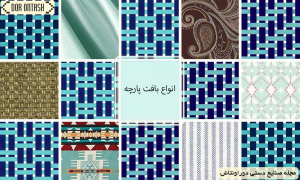
Simple texture
Simple and normal texture is the simplest and hardest type of texture. The warp threads are placed above and below the weft threads, the closer the rates, the denser and more compact the fabric. This fabric is similar on both sides and is produced easily and cheaply. Examples of plain weave fabrics include chalwar, taffeta, habutai silk, chit, linen, and mosuli fabric.
Serge texture
The texture of serge is very complex. Warp threads are seen on a large number of weft threads and can be identified by the diagonal stripes on the fabric. This strong texture is used for soft yarns such as wool and linen to make checkered woolen fabric, woolen fabric, denim and gabardine fabric.
fluffy texture
Loops of pile fabric or existing cuts, cause the formation of texture on the fabric.
Satin textures
Satin weaves (or sateen weaves) are created as a unit in which the warp or weft is placed over four or more threads to form the actual fabric layer. Examples of this texture include virgin satin, crepe satin, and silk satin.
Other tissues
Smooth, pile and satin textures can be combined in many ways to produce ribs and other types of patterns. Jacquard weaves have intricate patterns such as flowers, leaves and lettering. These textures can often be found on table cloths, evening dresses and soft accessories such as curtains.
Polar weaves are weaves with an extra layer or warp threads that create rings on the surface of the fabric that can be cut or looped on the left side. Velvet or striped cotton velvet are examples of polar-shear fabrics, and towel fabric is a looped pile.
Characteristics of woven fabrics
Woven fabrics have the following properties:
The edges are not worn until they are cut, because they are chamfered.
When the fabric is cut, it will fray.
They can be woven in different densities and have different weights.
The fabric is very strong because it has a linear grain.
The fabric can be stretched diagonally.
Making woven fabrics
Woven fabric is usually longer in its warp direction than it is wide, that is, it is longer in the warp direction than in the weft direction. The warp yarns pass through large rails called spindles or spools.
Typically, these reels hold about 4,500 individual pieces of yarn, each about 500 yards (450 meters) long. The filling yarns are fed through spools called bobbins, which are called weft bobbins, these bobbins are carried in makos (hollow projectiles) that move in the rear direction and among the fourth warp yarn, which are carried on some and pass under each other.
The mako is designed in such a way that the thread passes freely with the movement of the mako. Each length of yarn fed through the mako passes across the loom, which is called wefting. Thread floats are passed at the end of each weft and form another weft with the return of the mako.
When the yarn is used up in a particular loom, today’s looms have automatic devices that replace the empty weft bobbin with another bobbin.
Functions of the loom
Raising selected warp yarns with appropriate hardness, which are made of warp frames with rigid vertical wires and thread catch or strips with an opening in the middle.
For each of the final sections, there is a thread that opens through the thread holder. The weaver directs and separates the warp threads and raises some of them to provide space for the mako work during wefting. This action is called warp thread opening and the space between warp threads is called warp thread opening. Simple weaves only require two stitchers, while complex weave patterns require more than 403.
Wefting is the insertion of a length of filler thread or weft between the warp threads through the middle of the mako (a hollow projectile that holds the inner warp thread) that allows the warp threads to pass through.
Hemming or darning the filling thread through the weft versus just the next formed fabric forces the previous weft. This step is necessary, because the mako needs the necessary space to move in the loom and weft deposition is not possible near the previous wefts. Dafting is done with a bobbin, which connects the parallel vertical wires between the warp threads.
Taking up (the amount of liquid taken up by the fabric in the pad machine), the twisting of the garment that is formed on the take-up spool or the clothes reel.
When the garment is picked up, the warp thread is released from the weft spool. This action is called feeding the yarn to the loom.
Warp yarns may be worn with temporary measurements to guard against damage that may occur during operation. The process of using this coating is achieved by using larger yarns, which are called rod spools, they are passed through the comb guide and the starch source, and then they are wrapped on the warp thread, which is called the twisting process or Aharzni they say.

